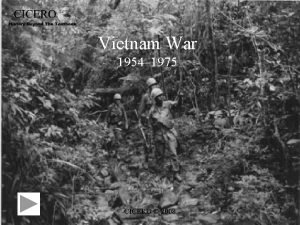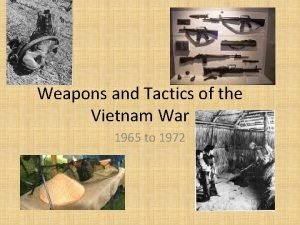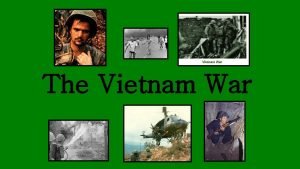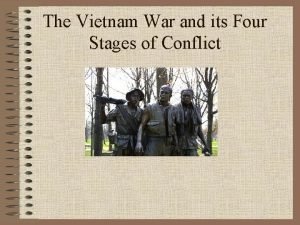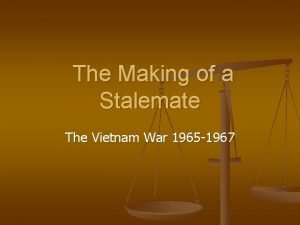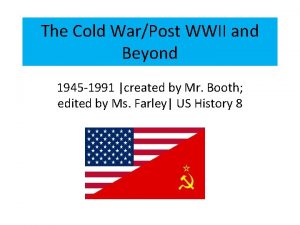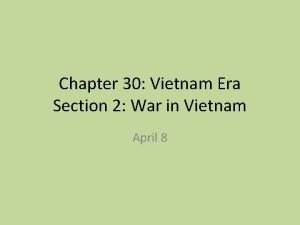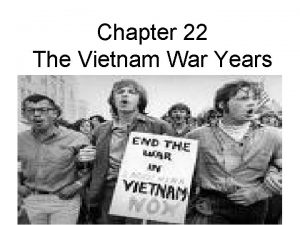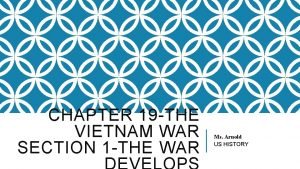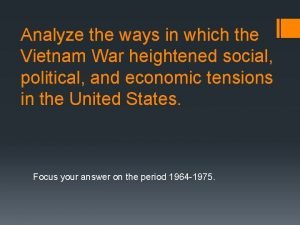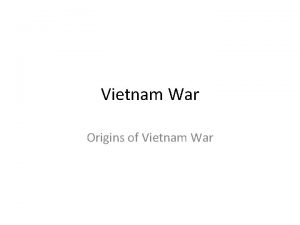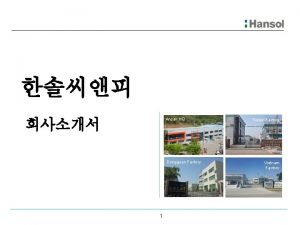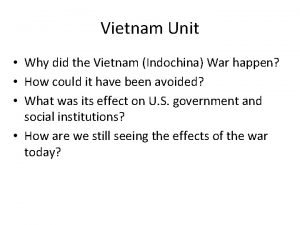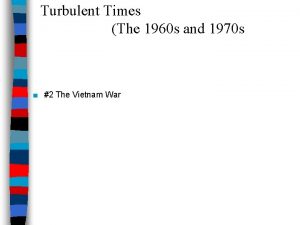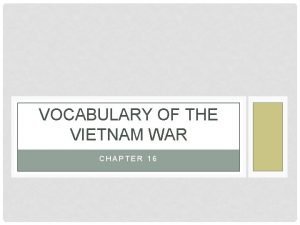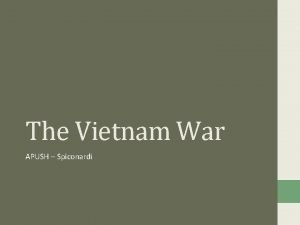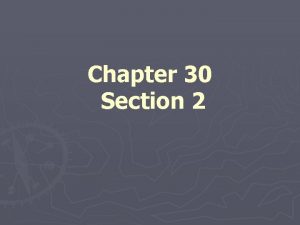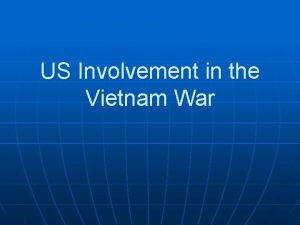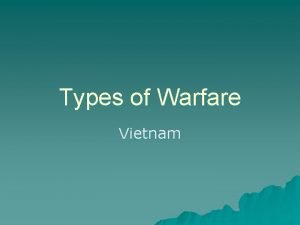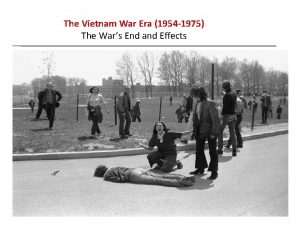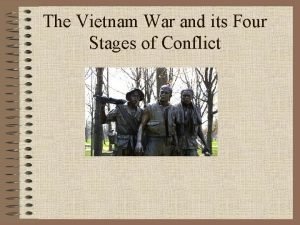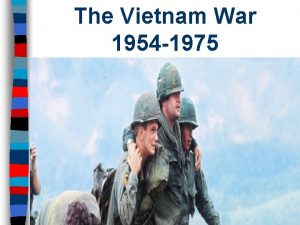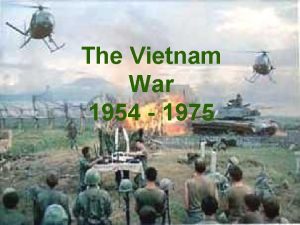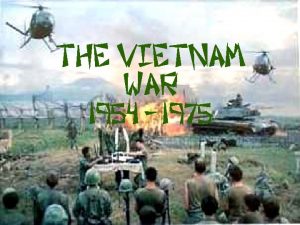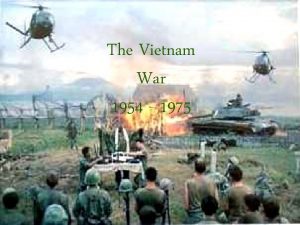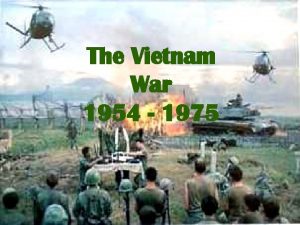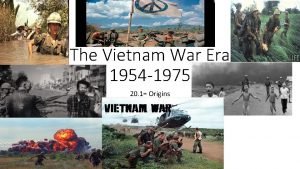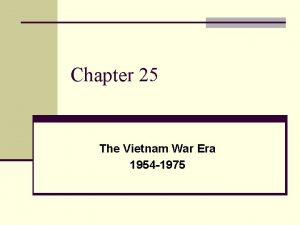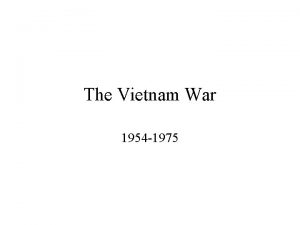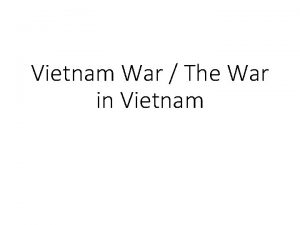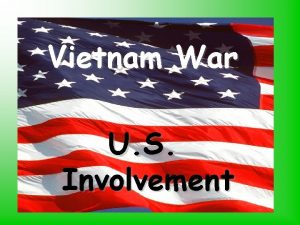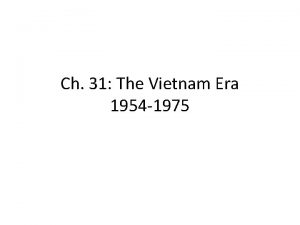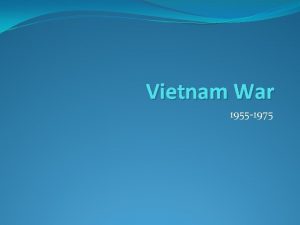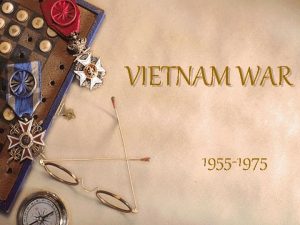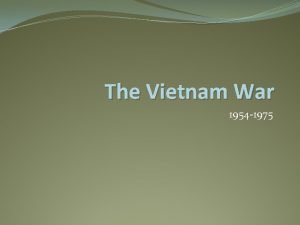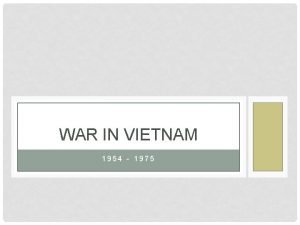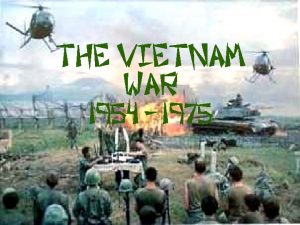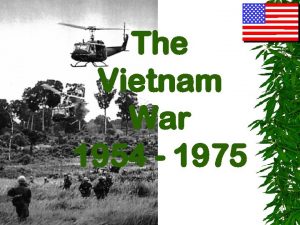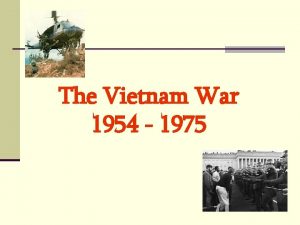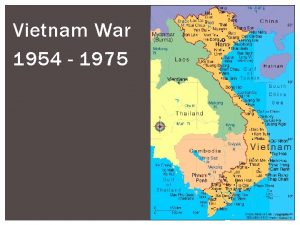The Vietnam War Era 1954 1975 Lesson 1

























- Slides: 25

The Vietnam War Era (1954 -1975) Lesson 1 The Cold War and Vietnam

The Vietnam War Era (1954 -1975) Lesson 1 The Cold War and Vietnam Learning Objectives • • • • • • Explain the steps Kennedy took to change American foreign policy. Analyze the causes and effects of the Bay of Pigs invasion and the Cuban Missile Crisis. Assess the outcome of the Berlin Crisis and other foreign-policy events of the 1960 s. Describe the reasons that the United States helped the French fight the Vietnamese. Identify ways in which the United States opposed communism in Southeast Asia. Analyze how the United States increased its involvement in Vietnam. John Kennedy Fidel Castro flexible response Peace Corps Alliance for Progress Bay of Pigs invasion Cuban missile crisis Nikita Khrushchev hot line Nuclear Test Ban Treaty Berlin Wall Ho Chi Minh domino theory Southeast Asia Treaty Organization (SEATO) Vietcong Gulf of Tonkin Resolution

I. Kennedy’s Presidency A. Election of 1960 1. Democrat - John F. Kennedy - Catholic 2. Republican – Richard Nixon – V. P.

– Cold War – Kennedy wanted to prepare the US to fight nuclear war and guerilla warfare • 1. Flexible response – Kennedy’s international policy to contain Communism. – Military, Economically, Politically • Create special forces – Green Berets – Fight any type of conflict » Eisenhower – “massive retaliation”

Cold War and Kennedy • Limit the Spread of Communism – Politically and economically help countries • Peace Corps – (1961) American Volunteers to assist developing countries – “Third World” – developing nations in Asia, Latin America – Provide technical, educational and Health Services • Alliance for Progress – economic development with other countries – Resurrect good neighbor policy with Latin America – $20 Billion to help Latin American countries » Industry, agricultural, health and welfare

Kennedy & CUBA • Cuba presented the first big test of JFK’s foreign policy – 90 Miles south of Florida – Dictator Fulgencio Batista dictator of Cuba • (anti-communist) – Could be controlled by USA • (1959) Revolution • Fidel Castro who welcomed aid from the USSR – Supported Communism – Eisenhower administration drew up plans to invade Cuba • CIA mission (Bay of Pigs) • US controlled 75% of the sugar crop 1. Castro promised to get rid of poverty • 2. Castro wins and takes over U. S. companies land 3. U. S responds by imposing trade barriers on Cuba 4. Cuba turns to USSR for aid

Kennedy Responds to Communism in Cuba Analyze Maps Based on the information in the map, what factors might have influenced President Kennedy's decision to launch the Bay of Pigs invasion of Cuba, in 1961?

BAY OF PIGS (1959) • CIA Operation/ Eisenhower – Train Cuban Exiles • Invade Cuba and overthrow Fidel Castro • Kennedy learned of the plan only nine days into his presidency • JFK approved the mission • Bay of Pigs was a disaster – 1, 200 Cuban exiles invade Cuba • 25, 000 Castro Cuban supporters backed by USSR – USA did not provide air support with invasion • JFK faced political ramifications Bay of Pigs Invasion – Awesome Histories

Berlin Wall • 1958 – Treaty – divided the city of Berlin • 1961 Khrushchev and Kennedy meet in Vienna • Khrushchev wanted the US to recognize formal division of German • • • Remove US troops from W. Berlin Khrushchev wanted to challenge the leadership of Kennedy Increase military spending • 1961 Russians build the Berlin Wall, separating East (commie) and West Berlin – Was built more for keeping in Communist citizens from escaping than for keeping us out – Skilled workers leaving E. Berlin – move to W. Berlin

Cuban Missile Crisis • USSR + Cuba – Nikita Khrushchev – Soviet Premier • Promises to support Cuba • Summer of 1962 – USSR shipment of weapons to Cuba include nukes – U-2 Spy plane, 1962 • Photographs of missiles in Cuba • Joint Chiefs want to bomb Cuba – JFK and advisors use diplomatic measures • US forces sent to Florida – JFK addresses public • “Quarantine” Cuba – Impose a naval blockade to prevent missiles from being delivered 13 Days – Quarantine Clip Ted Talk – Cuban Missile Crisis



13 DAYS • When more Soviet ships headed for the U. S. with weapons, JFK ordered a blockade • The first break in the crisis occurred when the Soviets ships turned back • Finally, Khrushchev agreed to remove the nuclear weapons from Cuba in exchange for a U. S. promise NOT to invade Cuba For 13 days in October, 1962 the world stood still as the threat of nuclear war gripped the planet

EASING TENSIONS • Impact of the Crisis – Kennedy seen as a leader – Khrushchev lost prestige – Reduce Nuclear Tensions USSR promises to remove missiles from Cuba and the US secretly promises to remove missiles from Turkey – leads to the Hotline • Move towards Détente – relax tensions between the two powers – Hotline – telephone communication between USA and USSR – 1963 – Nuclear Test Ban Treaty • Ended above ground nuclear tests • USA, Great Britain, USSR • 36 other nations also signed

Vietnam War • Pager U • Hip Hughes Vietnam Gulf of Tonkin

French Rule in Vietnam • China and Vietnam • Vietnam earned independence in 1428. • • • 1600’s French missionaries went to Vietnam Since the late 1800’s, the French ruled Vietnam, Laos, and Cambodia (French Indochina) • • Still close ties to China remained After WWII, France tried to regain control of these territories USA supported France with over 1 billion dollars…and military support (fear of communism) • Events in China and Korea help to convince the USA • Ho Chi Minh • starts a movement to rid Vietnam of both French and Japanese control. • The Japanese had taken control while France was busy with WWII. • Vietminh – nationalist group formed by Ho Chi Minh (Communists) • Get rid of foreign rule

French Rule in Vietnam: • Post WWII • Cold War • SEATO – Prevent communism from spreading in South East Asia • France struggle with North Vietnamese • USA concentrates on “Containing Communism” • • • In 1950, the US sent $15 million in aid to the French to help them defeat the Vietminh • Containment Policy Dien Bien Phu – French outpost – May 1954 French defeated • French Colonial Rule comes to an end. • Geneva Accords -1954 • Divide Vietnam (17 th Parallel) • North Vietnam – Communist • Ho Chi Minh • South Vietnam – Anti-communist

Domino Theory • Belief that if one country fell to Communism, then eventually the rest of the world would become communist.

The US Steps In: • Ngo Dinh Diem – Leader of South Vietnamese Government • USA (Truman & Kennedy) Support Diem • Vietcong – – North Vietnamese Militant Group Support Communism attacks on Diem’s government assassinated thousands of South Vietnamese government officials. • Ho Chi Minh supported the group with weapons and money • He sent supplies via the Ho Chi Minh Trail

Reasons for U. S. Involvement in Indochina Analyze Maps Based on the information in this map, which regions of present-day Vietnam were particularly dangerous for French forces?

Reasons for U. S. Involvement in Indochina Analyze Charts Based on the graphic, were U. S. leaders concerned about the spread of communism only in Southeast Asia or did they fear it would spread worldwide?

Kennedy and Vietnam: • Kennedy initially sent Diem more supplies, money, and military advisors – Billions of dollars and military personnel – Diem misused resources • By the end of 1963, 16, 000 US military personnel were in South Vietnam • Diem faced turmoil – Communists rebellion – Buddhist rebellions – also attacked Buddhists (he was Catholic) – He burned temples, and killed hundreds of Buddhist clerics (some protested) • Majority of population was Buddhist • Diem is assassinated Nov 1963 – Rumors of a coup heard by American intelligence officers – Kennedy originally supported a coup – America denied involvement in the coup of Premier Diem – Kennedy assassinated a week later

Johnson and Vietnam 1963 -1968 • Kennedy wanted to withdrawal troops by 1965 – Vice President Johnson takes over • Gulf of Tonkin August 1964 – A U. S. SHIPS ATTACKED BY N. VIETNAMESE. IN GULFOF TONKIN – USS Maddox opened fire on the patrol boat – Johnson decided then to start dropping bombs on North Vietnam • Operation Rolling Thunder – Two days later, the American ships reported enemy fire and opened fire on enemy ships • (later it was found that there was no enemy fire)

The Tonkin Gulf Resolution: • Johnson asks Congress to use military • Congress Authorizes Johnson to use military force • “A BLANK CHECK” • Tonkin Gulf Resolution • granted Johnson broad military powers in Vietnam • “WHATEVER NECESSARY” to fight N. Vietnam • No Official Declaration of War – THE DRAFT STARTS = TROOPS FLOOD INTO VIETNAM

 Vietnam 1954
Vietnam 1954 Korean war vietnam war venn diagram
Korean war vietnam war venn diagram Presidential and radical reconstruction venn diagram
Presidential and radical reconstruction venn diagram The cold war lesson 1 the cold war begins
The cold war lesson 1 the cold war begins Toward civil war lesson 3 secession and war
Toward civil war lesson 3 secession and war Us weapons vietnam war
Us weapons vietnam war Vietnam war results
Vietnam war results Vietnam war stages
Vietnam war stages Did the vietnam war end in a stalemate
Did the vietnam war end in a stalemate Vietnam war at home webquest answers
Vietnam war at home webquest answers Vietnam war causes
Vietnam war causes The vietnam war years chapter 22
The vietnam war years chapter 22 President nixon endorsed vietnamization because
President nixon endorsed vietnamization because Analyze the ways in which the vietnam war heightened social
Analyze the ways in which the vietnam war heightened social Vientcong
Vientcong Vietnam war
Vietnam war Operation rolling thunder cold war
Operation rolling thunder cold war Vietnam war 1960
Vietnam war 1960 Vietnam war vocabulary
Vietnam war vocabulary Vietnam war apush
Vietnam war apush Chapter 30
Chapter 30 Vietnam
Vietnam Vietnam war traps
Vietnam war traps Reason for vietnam war
Reason for vietnam war Effects of the vietnam war
Effects of the vietnam war Stages of the vietnam war
Stages of the vietnam war
